|
|
 |
|
|
The Siege of Calais, May 1940
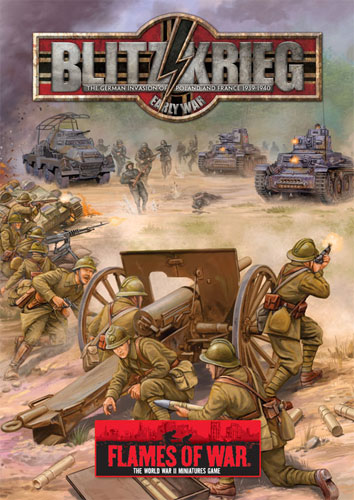
|
The Siege of Calais, May 1940
by Paul Goldstone
The siege of Calais in May 1940 was one of the epic battles of the French campaign. In an attempt to stop the rapid German advance, a tiny force of crack British riflemen were landed at Calais, only to be overwhelmed after a heroic stand of three days.
In May 1940 the Germans broke through the French defences, and tore through into the rear of the main British and French armies, with XIX Panzerkorps under General Heinz Guderian reaching the French coast on 20 May. This cut the British Expeditionary Force (BEF) from its supply ports further south, forcing the British to consider using the port of Calais to supply the BEF from.
Learn more about Blitzkrieg here...
|
To secure the port against what was optimistically believed were a few German tanks, and open supply lines to the BEF, on 22 May the Queen Victoria Rifles, a Territorial motorcycle battalion, were landed at Calais. However, the Queen Vics were landed in an incomplete condition, short of weapons and ammunition and without their motorcycles. They set off on foot or in commandeered French civilian vehicles to establish roadblocks around Calais - by early the next day, the Queen Victoria Rifles, with some brave personnel from 1st Searchlight Regiment, were scattered behind hastily erected barricades guarding the roads around Calais. Far from the small number of German tanks expected, several Panzer Divisions were sweeping north towards Calais. On the afternoon of 23 May, the leading elements of the German advance began to clash with the British roadblocks. The 1st Panzer Division was probing for entry into Calais, but their attempts were delayed by the little roadblocks of Territorials and Searchlight personnel armed with nothing except their rifles and a few Bren light machine-guns.
|
At the same time that the Queen Victoria Rifles were landed, the 3rd Battalion Royal Tank Regiment (3RTR) was also landed. It is symptomatic of the confusion in the British high command that they were landed with little reference to the Queen Victoria Rifles, and without a clear mission. Conflicting orders were received, but on the 23 May the 3RTR set off in drizzling rain to the south-east, pushing through crowds of French refugees. The battalion had got as far as the village of Guines several kilometres from Calais, when it struck a column of German motorised troops from 1st Panzer Division. After a sharp and confused action amongst the farms and fields, in which 3RTR lost several tanks, the 3RTR broke off and returned to Calais. It was now clear that the Germans were advancing in considerable strength.
As the fighting raged outside Calais, the British landed two crack rifle battalions - the 1st Battalion The Rifle Brigade, and the 2nd Battalion King's Royal Rifle Corps (The 60th). They were under the command of a talented Brigadier, Claude Nicholson. Both the battalions were descendents of the famous greenjacketed rifles of the Napoleonic Wars.
Right: Calais, France.
|
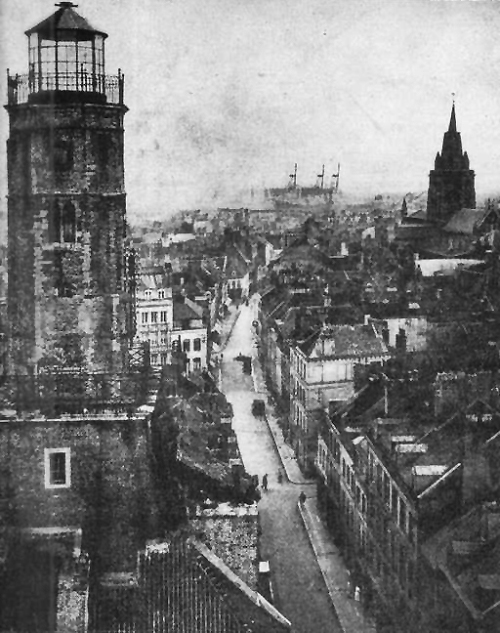 |
"My own tank was a cruiser type A9, which only had a smoke howitzer and one MG on it. This was not encouraging, as I could only watch other tanks fighting and not hit back myself. Soon one tank after another was put out of action. It was obvious we were outgunned and outnumbered, and the only thing was to withdraw back to Calais. My tank would at least put down smoke so with its help, and the help of two other 'smoke tanks', we put down a smoke screen and withdrew to a ridge between Coquelles and Calais."
- Major Reeves, 'B' Squadron, 3rd Royal Tank Regiment.
|
| In the 1930s the Greenjackets had
undergone something of a change of role, becoming the first motorised
infantry battalions in the British Army. These two battalions of highly
experienced regular soldiers had been in England training with the 1st Armoured Division. |
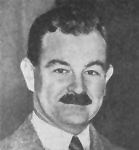 |
However, they were not destined to fight in that
role. The need to protect Calais was acute, and the two battalions were
ordered to proceed in haste to Calais. The transport of the riflemen was
undertaken in a rush, and the two battalions were forced to disembark
while under German air attack, resulting in the two battalions being
landed on the Calais docks with little of their transport and Scout
Carriers, and short of ammunition and many of their weapons (especially
anti-tank rifles). They were joined by eight 2pdr guns from 229
Battery of the Royal Artillery.
Left: Brigadier Claude Nicholson. |
On the night of 23-24 May, it was decided to send a supply convoy to the BEF in the north. Some cruiser tanks and four platoons of riflemen set off with a convoy of Lorries to the north-east, but immediately ran into German forces - Calais was surrounded.
|
The two rifle battalions occupied a line based on the old brick and earth bastions and ramparts surrounding the town and port. The old defences were defensible against most direct fire weapons, but vulnerable to shellfire. But in parts the bastions had been pulled down for new housing or railway lines. The two rifle battalions formed the basis of the defence, with the 60th taking up positions on the west and the Rifle Brigade taking up positions to the east. They were augmented by platoons of Territorials from the Queen Victoria Rifles, some Searchlight personnel, some surviving tanks from 3RTR, a few 2pdr anti-tank guns, and a number of French Reservists from the 265e Infanterie Regiment. This gave Nicholson a total of around 4,000 men, too few to hold the perimeter for long under a sustained attack.
On the 24th Guderian ordered the 10th
Panzer Division to close in on Calais.
The 86th Schützen Regiment supported by Panzer
Aufklärung Abteilung 90 (90th reconnaissance regiment), Panzerpionier Battalion 49, and several
tanks, attacked from the south and west. Fort
Nieulay, on the outskirts of Calais, was held by
French reservists.
Right: The entrance to Calais.
|
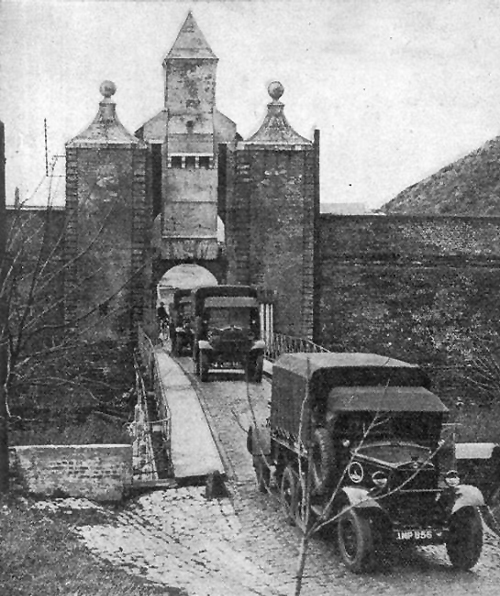
|
| These held out for several hours before being overwhelmed.
The 86th Schützen Regiment also pressed forwards into the western suburbs of
Calais, clashing with the 60th Rifles amongst the houses and gardens. From the
east, the 69th Schützen Regiment closed in, battling the Rifle Brigade on the
eastern defences. The built up nature of the town permitted the Schützen to
infiltrate into the defences. German mortars, with their plunging fire, were
able to inflict considerable casualties on the defenders. A series of often
disjointed but fierce battles raged in the suburbs and around the fortress
walls. |
"On the last hill we stop and wait for the dawn. Before us, in the yielding foggy dust of dawn we perceive the sea. We are all joyfully excited and moved, from the commander of the Schützen brigade to the private soldier. Now we know: the assault of the Schnellen truppen has succeeded. We are standing only some kilometres from the Channel. This moment at Calais, as if emerging from the sea, red like blood, the sun rises. The many roofs, gables and towers, the old lighthouse and rows of cranes seem to be silhouettes. The Town halls tower tops them all. From the west and south the schützen brigade attacks at dawn. Platoons of the reconnaissance battalion and of the motorcycle company, combat groups reinforced by heavy MG's and mortars, advance. The target is the railway line which, in the west runs like a fortification along the whole town, and the Fort Nieulay. It is to be taken by a surprise raid."
- Hubert Borchert, Photographer with 86. Schützen Regiment, 24 May 1940.
|
| By the nightfall of 24 May the situation on the west and south-western perimeter had become critical, as German tanks had been able to push through. Brigadier Nicholson ordered the 60th Rifles to pull back to the old town. The old town was surrounded by the Canal de Calais and the basin Carnot, with three wide bridges spanning the canal - Pont Freycinet, Pont Georges Cinq and Pont Faidherbe. But there was nothing to blow up the three bridges, forcing the defenders to hastily erect a barricade from their trucks and wreckage. |
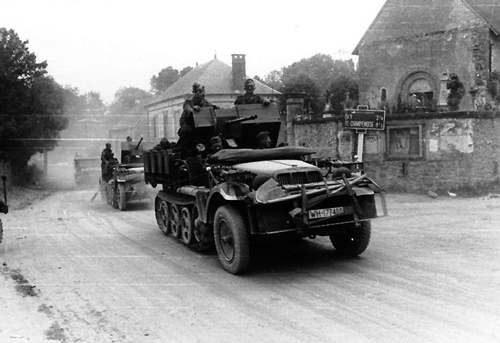 |
The Rifle Brigade held
positions in the eastern part of Calais, protected by part of the old
perimeter ramparts and the Canal de Calais. Barricades were erected, and
the houses overlooking the canals were quickly turned into defensive
positions. However, while the riflemen had a much shorter perimeter to
defend, the Germans were able occupy buildings which overlooked the
British positions, including the clock tower of the town hall. Snipers
were installed in the tower, from which defenders manning their
barricades and houses were steadily picked off.
Left: The German advance rapidly towards Calais.
|
"After about an hour of peering and wondering and waiting - it happened. A German tank lumbered slowly and ominously into view and stopped about 200 yards away. Some trigger-happy machine-gunner opened up on his own and all hell was let loose. The section I was in deployed to the right to approach at an angle to engage it with our Boys Anti tank gun… as we crouched and edged forward…we were met with a heavy burst of machine-gun fire. The section scattered leaving two dead and retreated hastily to the main party at the roadblock where the rest of them were heavily engaged firing at German soldiers advancing behind the tank. The air was filled with whining shells and bullets and it was obviously impossible to hold such a force so we disengaged."
- Rifleman Sam Kydd.
|
|
At 11:00am on the 25 May, General Schaal,
commander of 10th Panzer Division, demanded that the defenders surrender
Calais, threatening that he would bomb and shell Calais to the ground if his
demands were not met. "No, I shall not surrender. Tell the Germans that if
they want Calais
they will have to fight for it." replied Brigadier Nicholson. This brought
about a ferocious bombardment of the inner city from artillery and Stuka dive bombers,
after which Schaal once again demanded the surrender. Nicholson responded
"The answer is no. As it is the British Army's duty to fight as well as the Germans."
At 4:35pm the battle resumed with increased ferocity. The fighting was house-to-house, with the British defences being broken up into smaller and smaller pockets. However, the British infantry hung on stubbornly, the excellent marksmanship of the riflemen inflicting a heavy toll on the attackers, and forays by the remaining tanks of 3RTR helped to repel German attacks.
Right: A German Stuka delivers it's payload.
|
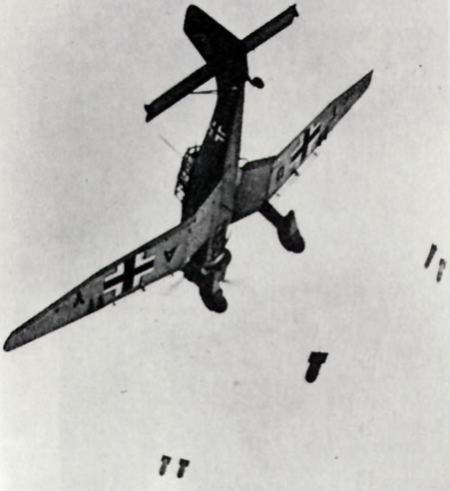 |
"A hot day the 25 May; there is heavy fighting for every inch of ground. The Citadel of Calais must be ripe for the assault. Shell after shell roars out of the German barrels towards the bunkers and heavy fortifications. Heavy tank hunters, engineers with rafts, assault engineers, field howitzers and light AA for ground support of the rifle companies are drawn forwards. In the evening at 6:30pm a surprising hurricane of fire; hit after hit crashes high over the citadel and Fort Risban at the mouth of the harbour. The officers look to their watches: ten minutes, five, and then the firing stops! The sudden silence is very impressive. It is 7:40pm. The storm troops advance with much doggedness. The guns fire in open positions. The heavy and light tank hunters and the 2cm AA guns send shell after shell out of the quick firing barrels. The infantry support guns and the trench mortars are thumping. Riflemen and engineers jump forward; the machine gunners hammer as if crazy. All men are fiercely determined. Comrades fell, were wounded, and others jump forward. There is only a slow advance. The adversary defends himself with the courage of despair. Form all sides the German storm troops were fiercely fired upon. But they advance. They open passages in the west of the town by force, step by step."
- Hubert Borchert, 10th Panzer Division.
|
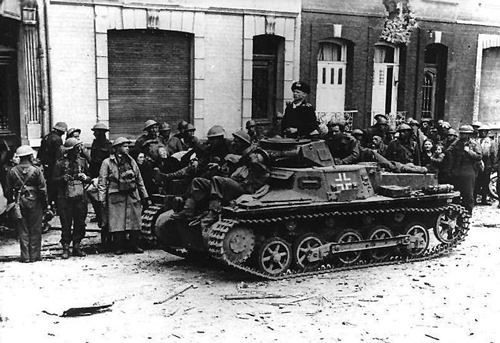 |
The Rifle Brigade was gradually forced to fall back through the streets towards the old town and harbour, fighting from house to house. At Pont Richeleu the combined attacks of German infantry and tanks were repulsed. At Pont Freycinet the Germans were able to cross in the face of resistance from the riflemen in the surrounding houses, but a spirited counterattack from the British riflemen sealed off the breach. As darkness fell, the fighting petered out, ending with another air attack from Stukas.
Left: A German Panzer I advances past British POWs. |
| “The
Enemy fights with a hitherto unheard-of obstinacy. They are English,
extremely brave and tenacious. They have at least one reinforced
infantry regiment, armour supporting them and naval guns firing from
ships in the Channel.” was recorded the 10th Panzer Division war diary. The surviving British and French defenders prepared their final
positions, while the Germans opposite brought up artillery and AA guns
into the front to blast the defenders from their positions. That night a
few small boats managed to make it to Calais and withdraw some wounded
and rear echelon personnel; but the port was now cut off. |
At 5:00am on the 26 May the 10th Panzer
Division renewed their assault with a massive artillery and air bombardment.
From 7:00am wave after wave of Stuka dive bombers joined in, turning the
shattered old town into an inferno. At 9:15am the infantry assault commenced.
In the face of desperate resistance, the barricades over some of the bridges
were cleared, and panzers entered the old town. This rendered the British
defence hopeless, as the tanks were able to blast apart each house that showed
resistance. At 4:40pm the citadel fell.
Right: British POWs march into captivity. |
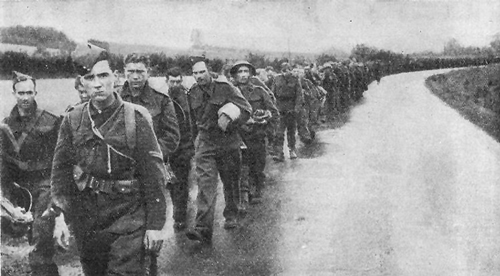 |
| The surviving defenders pulled back
towards the houses, warehouses and quays of the harbour itself, fighting every
step of the way. By the evening the last of the resistance was crushed. That
night a Royal Navy patrol boat, the Gulzar,
managed to creep into the harbour entrance and rescue about 50 men, but the
rest of the defenders were forced to surrender. |
"At 1730 city, citadel and harbour entrance in our hands. High spirits in this moment dominate in the command posts in the Theatre. Proudly we think of our brave stormtroopers… It was a hot bitter struggle to take this fortress, England's entrance to France. Even the unexpected obstinate defence of the Englishman proves to us that he knew the worth of Calais in all its importance, and therefore the loss of the town must be more grievously felt. Shortly afterwards we hear in the Supreme Command’s report the laconic statement ‘Calais captured’. Of the hard struggles which preceded the fall came nothing which could be known at home. Tenaciously the fort had been defended – even more tenaciously our Rifle Regiments had fought… determined o gain their end. So many heroes after the hard fight are now covered with cool earth… beside sedan and Somme now Calais too, was entered on the division’s page of glory.”
- Von Oberst Fischer.
|
Post-War Controversy
At the time, the siege of Calais was regarded by the British as a heroic last stand, in which the sacrifice of the rifles delayed the panzers long enough for the BEF to form a defence on their exposed flank - the Greenjackets stand at Calais saved the BEF. After the war however, it has been pointed out that the Germans stopped the advance because of Hitler’s Halt Order of 24 May, which stopped the panzers from going north for two days - the Greenjackets stand at Calais was a useless sacrifice. However, when the Germans resumed the advance north it was without 10th Panzer Division, which was still tied down in Calais. Given how close the fighting was for the resultant battles for the southern flank of the BEF, it may be that the absence of a single panzer division prevented a total breakthrough.
~ Paul. |
Sources
Airey Neave, The Flames of Calais. Grafton Books, 1972.
Gregory Blaxland, Destination Dunkirk: the story of Gort’s army, Kimber, 1973.
Hugh Sebag-Montefiore, Dunkirk:Fight To The Last Man, Harvard University Press, 2006.
Jon Cooksey, Calais: Fight to the Finish - May 1940, Pen & Sword Books, 2000.
R.H.W.S. Hastings, The Rifle Brigade in the Second World War, 1939-1945, Aldershot 1950.
Roger Nixon, The Annals of the King's Royal Rifle Corps, Volume VI 1921-1943, Leo Cooper 1971.
William Moore, Panzer Bait: with the Third Royal Tank Regiment, 1939-1945, Leo Cooper, 1991.
Patrick Delaforce, Taming the Panzers : Monty’s tank battalions : 3 RTR at war, Sutton, 2000.
|
Want To Know More About Blitzkrieg?
Over the past few months we have added a massive range of articles
about Blitzkrieg to the website, to make it easier for people to find a
specific article we have put together this handy place.
Find out more about Blitzkrieg and Early-war here...
|
Last Updated On Thursday, June 23, 2011 by Blake at Battlefront
|
|
|